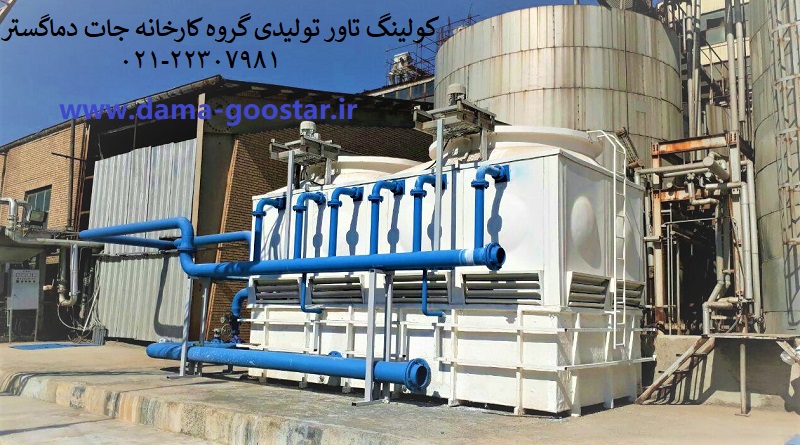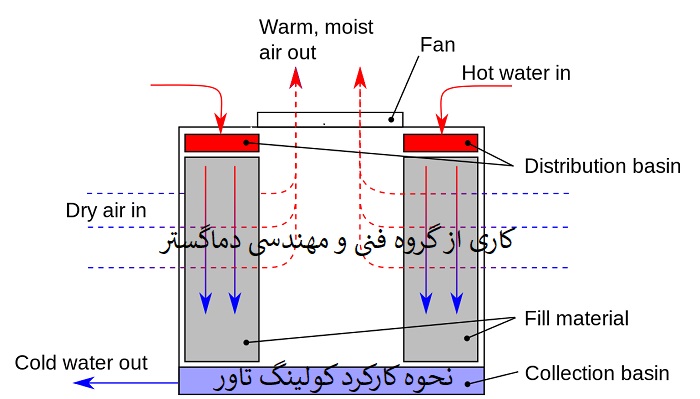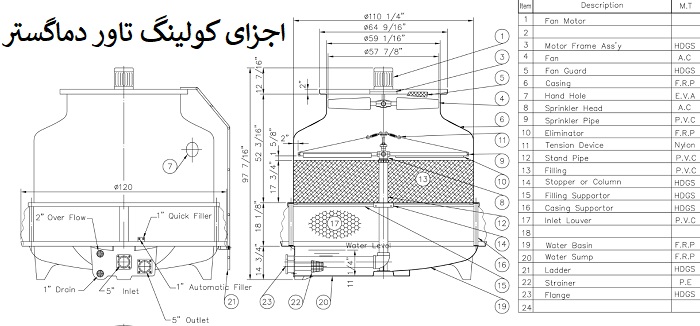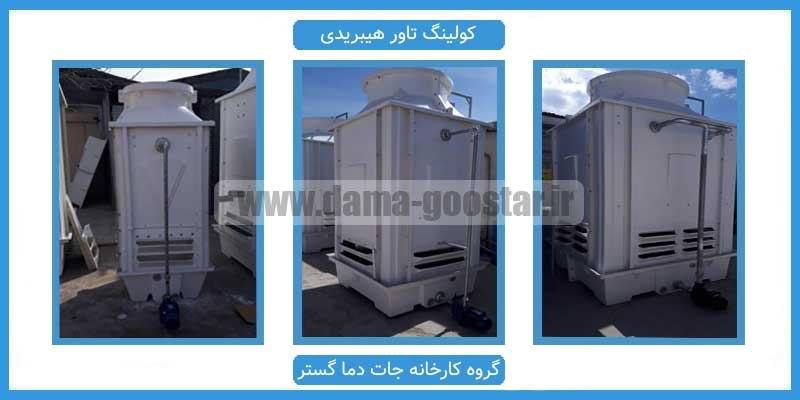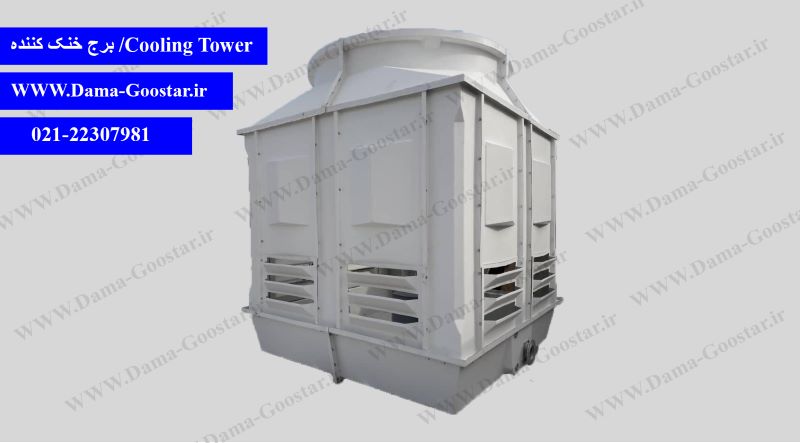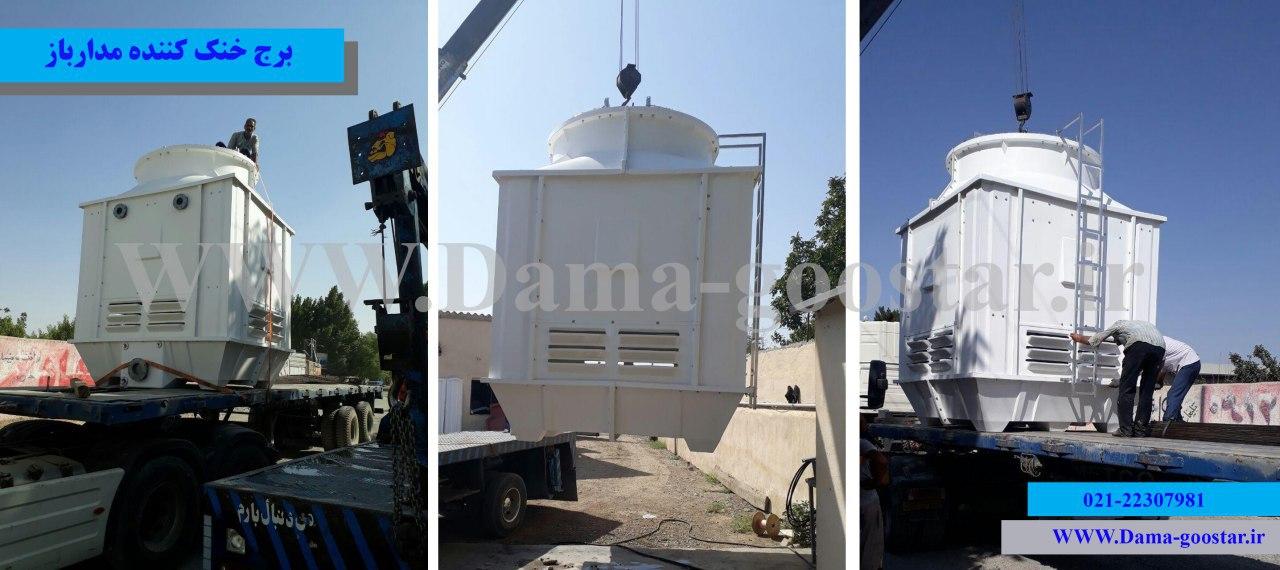
As you are aware, the basis of most types of cooling towers is based on the latent heat transfer of evaporation from water to air and thus the creation of humidity in the air. This model of industrial cooling is called wet cooling tower (open cooling tower).
Why do we also call open cooling tower wet ??
The main reason for naming this equipment as a cooler or wetter tower is to create high humidity in the air (100% humidity) and in other words, to convert dry inlet air into saturated air at the outlet of the cooling tower.
How does a wet cooling tower lower the water temperature?
Open or wet cooling tower originally evaporates a small amount of water flow (approximately 1%) by creating a direct contact (at cooling levels) between the weather and the heat required to evaporate this amount of water by the main stream of water. And causes the mainstream water temperature to cool (99% remaining).
As expected, in this model of the cooler tower, heat and mass transfer occur simultaneously. Heat and heat energy transfer from the water stream to the air stream and in this energy transfer due to the entry of water vapor into the air, a kind of mass transfer also takes place. In fact, in a nutshell, a wet cooling tower cools the water during a return process by simultaneously transferring heat and mass. For this reason, this cooling model is also called open circuit cooling tower.
An important point to observe: In a wet cooling tower, due to the evaporation of a part of the water flow and its loss, it is necessary to add a certain amount of compensatory water to the circulating water flow in order to compensate for this evaporation and loss. For this reason, this model of cooling towers is mostly used for areas that have no problem in supplying this amount of compensatory water.
Auxiliary article link: Calculating compensatory water in the cooling tower
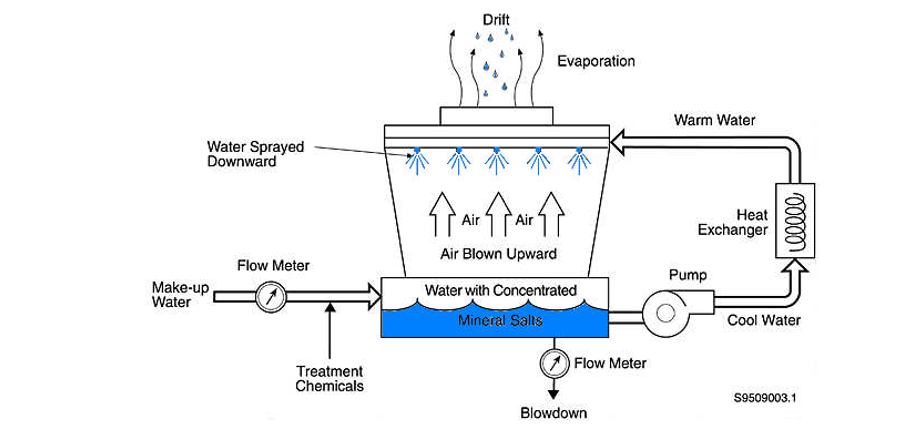
The purpose of a wet cooling tower is to cool the water.
In many industrial environments, water is used to cool appliances and equipment that generate heat (such as condensers, heat exchangers, turbines in power plants, and chillers in air conditioners). This fluid after cooling , Recovered and returned to the industrial environment for reuse. This is done by cooling the hot water in the wet cooling tower by contact with a stream of unsaturated air, which leads to a percentage of water evaporation and sensible heat transfer as well as latent heat of evaporation from water to air and thus cooling. Water (in adiabatic conditions).
The cooling process in the wet cooling tower is done in such a way that the high temperature water flow (hot water) after entering and passing through the packings or cooling surfaces is in contact with the fresh air flow of the outside environment and is cooled. And accumulates cold water in the pan or storage tank (the air flow entering the cooling tower can be natural air entering through the louvers or the induced air flow created by the fan or impeller)
In the fluid circulation cycle in a wet cooling tower, water containing heat is exposed to direct contact with the air stream, and when the weather is in contact, the water temperature begins to decrease for two reasons.
1) Direct heat transfer from water to outside air due to the difference between inlet hot water temperature and dry outdoor air (tangible heat)
2) Indirect heat transfer due to evaporation of part of the water flow and as a result of water heat consumption to provide the necessary energy for evaporation (latent heat of evaporation)
Parameters affecting the better performance of the wet cooling tower
Spray and spray water flow at the outlet of nozzles or nozzles (water dispenser)
Cross Sectional Area
The amount of aeration or volumetric flow of induced air flow created by the suction or blowing fan (Air Flow)
Non-sedimentation of internal equipment over time due to constant evaporation of water flow in areas such as nozzles, packing, water dispenser
Smooth rotation of the cooling tower impeller and simultaneous static and dynamic fan balance
Application of wet cooling tower
Wet cooling tower, which is considered as one of the most widely used sources of cooling and water cooling, is used as an important component in many industrial and commercial processes. In fact, in expressing the application of wet cooling tower, two basic cases can be mentioned.
Chiller cooling tower: Cooling the chiller condenser circuit
Industrial cooling tower: Cooling of circulating water in industry such as oil refineries, petrochemicals, smelting and rolling metals in induction furnaces and nuclear power plants
Benefits of Wet Cooling Tower

Convenient economic efficiency compared to CCTV and hybrid cooling tower types
No harm to the environment in terms of creating biodegradable pollutants
Very high efficiency due to the creation of a direct heat exchange surface between the climate
Lighter and portable in all types of fiberglass cooling towers
Reduce the outlet cold water temperature to close to the humid ambient temperature
Production time of wet cooling tower is much shorter than hybrid and dry types
Low maintenance costs due to the low price of peripherals compared to dry and hybrid cooling towers
Easy maintenance
Ability to assemble on site and in very large dimensions
Creating the ability to assemble and produce in a multicellular way and thus control energy consumption
Evolutionary process in the wet cooling tower
First, let's take a look at the wet cooling tower process.
The use of natural flow cooling towers began in Europe and Germany. The construction of this wet cooling tower was initially made of wood and over time it was made of wood and metal. In the new type, the wet cooling tower is made of reinforced concrete. The physical shape of this type of cooling tower also underwent changes. First it was constructed in the form of a cylinder and later it was built in the form of two cut cones on top of each other. Its new shape is hyperbolic, which gives good strength to the wet cooling tower and is better compatible with the natural flow of air passing through the tower shell. The new design of this tower needs less materials because it needs less volume.
Wet cooling tower types
Wet cooling tower opposite flow
Cross-flow wet cooling tower
Cubic wet cooling tower
Wet conical cooling tower

1-1) Wet cooling tower upstream
If in a wet cooling tower, water is sprayed under a counter-flow (non-aligned) with the air flow, the cooler is of the counterflow or counter-flow type (Counter Flow Cooling tower). Opposite flow cooling tower generally has dry air inlet from all four sides. Opposite flow wet cooling tower is very efficient due to air suction and air contact with water in different layers of packing media. In practice, this model of industrial coolers is recommended for environments with low and medium relative humidity.
Opposite flow cooling towers are typically used in arid areas with low relative humidity. This equipment will have a much higher efficiency in arid areas than other types of cooling towers. In arid and tropical regions, due to the large difference between dry temperature and humid ambient temperature, water flow in different stages (packing layers) is reduced and in each layer of packing or cooling surfaces will have a certain amount of temperature decrease. In other words, in a wet cooling tower, the opposite flow of water in the altitude factor (HTU) and the large number of layers of cooling surfaces is in contact with the air flow and the temperature decreases gradually.
1-2) Wet cooling cooling tower
If the air in the cooling tower is sucked from both sides and the dry and cool air flow is inlet cross (perpendicular) to the water flow flow, this equipment is considered as cross flow or cross flow (Cross Flow Cooling Tower). Cross-flow cooling tower mainly has air inlet (Louvre) from both sides. This type of open circuit cooling is generally in uniform contact with dry inlet air in all packing layers or heat exchange surfaces.
Due to the uniform contact of the air with the water of the wet cooling tower, cross-flow is mostly used in areas with high relative humidity (sultry areas) such as the north and south of the country. This type of cooling is actually designed by creating surface temperature reduction units or NTUs in the field of water temperature reduction. By passing the air flow seamlessly through the packing media, the fresh air with the lowest relative humidity is in contact with the water flow and during this contact the water will face a decrease in temperature. Therefore, it can be inferred that the cross-flow cooling tower has larger dimensions than the reverse flow cooling tower.
The main units in the design of wet cooling tower are cross-flow type in the design of NTU units (number of surface heat transfer units in the Cooling Tower). This open-circuit cooling model also has the ability to produce a rectangular shape, which indicates a better location of the cross-flow cooling tower compared to the counter-flow types. Due to the reduction of HTU units in the design of open circuit cooling tower with cross flow air circulation system, the final height of this equipment is smaller than the height of other types of wet cooling towers.

1-3) Cubic cooling tower
Cubic Cooling Tower (Cubic Cooling Tower) is one of the types of open circuit cooling with a fixed water spray system, which is why this cooling tower model is named because of its appearance (cubic shape). The water distribution and spraying system in a cubic cooling tower actually consists of a series of fixed spray nozzles (Nozzle) or in the so-called water spray nozzle (like a shower head). The water at the outlet of these nozzles is sprayed and sprayed on the packing or cooling surfaces. The aeration system of the cubic cooling tower can be designed in the type of fan or impeller and axial blower or centrifugal fan. Cubic wet cooling tower is generally produced and supplied with FRP fiberglass body and HDGS galvanized .
The cooler tower with cubic structure has a lot of applications compared to other types of cooling towers due to the fixed water spray system. Cubic open circuit cooling tower has a higher efficiency than circular cooling types due to further reduction of outlet water temperature. Cooling towers with these specifications are generally easier to maintain due to the lack of a rotating water spray system.
This equipment has Void Space or less empty space in terms of covering the packing surface with water, and the main reason for this in the cubic cooling tower is the presence of a square spray nozzle in the production of this equipment. Square spray nozzle or spray deck with the necessary overlap in the design of this equipment prevents the creation of any empty surface without spraying water on the cooling tower straw. In fact, the cubic wet cooling tower has numerous advantages over the circular cooling tower in terms of water spray system design.
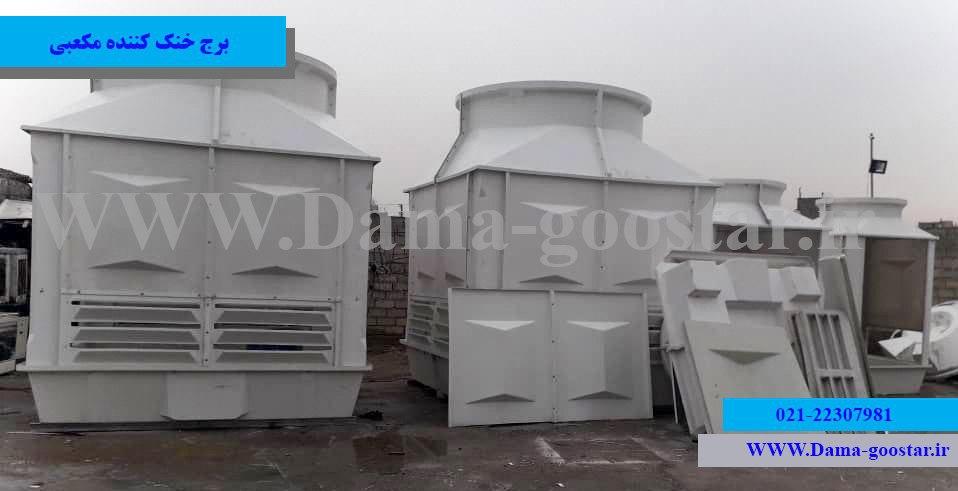
1-4) Circular cooling tower
The Round Cooling Tower also has a Rotary Water Distrobtion system and the main reason for this name is due to the rotating and conical appearance of this model. The spraying system of this equipment usually has a water dispenser or a central sprinkler head (Sprinkler Head). The circulating cooling tower water distributor is responsible for distributing the water flow on the media packing surfaces in a rotating and rotating manner. The air circulation system of this model of circular industrial cooling is generally of the axial fan type and more in the induction suction type.
Cone wet cooling tower mainly has larger surface dimensions than cubic cooling. The reason for the larger dimensions of this equipment is to create a lot of empty spaces that are created by the outlets of the pipe branches from the water dispenser. On the other hand, due to the large surface area in the circular cooling tower, this type of cooling tower is mostly used in spaces with height restrictions. Capacities above 150 tons of refrigeration are mostly assembled and designed on site. The eliminator or dripper section also has poorer performance than the honeycomb drip tower of the cubic cooling tower. The reason for the poor performance of the circular eliminator is the lack of coverage of the high surface of the water dispenser outlet in the cylindrical cooling tower.

